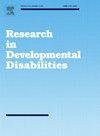Development and psychometric properties of the Italian little developmental coordination disorder questionnaire (LDCDQ-IT)
IF 2.9
2区 医学
Q1 EDUCATION, SPECIAL
引用次数: 0
Abstract
Background
Early identification of Developmental Coordination Disorder (DCD) in children is fundamental to provide the best chance of improving their outcomes. The Little Developmental Coordination Disorder Questionnaire (LDCDQ) is a screening tool to identify preschool children who may warrant a diagnosis of DCD.
Aims
This study conducted a transcultural translation and adaptation of the Italian version of the Little Developmental Coordination Disorder Questionnaire (LDCDQ-IT) and evaluated the psychometric properties of the tool, establishing also the optimal cut-off scores.
Methods and procedures
Parents/carers of 3- and 4-year-old Italian preschoolers completed the LDCDQ-IT (n = 352 typically developing children; n = 24 children at risk for motor coordination problems). One sub-sample (n = 52) completed the LDCDQ-IT a second time; another sub-sample (n = 90) was assessed using the Movement Assessment Battery for Children (MABC-2).
Results
The LDCDQ-IT showed high internal consistency (α=0.96) and good test–retest reliability. Children’s age and gender did not influence total scores. Correlations obtained between the LDCDQ-IT and MABC-2 total scores (r = 0.52, p < 0.001) suggest concurrent validity of the LDCDQ-IT. Using a cut-off score of ≤ 65, overall sensitivity and specificity were 79 % and 75 % respectively. Conclusions and implications: The LDCDQ-IT demonstrates promising psychometric properties, making it a useful tool for the early identification of DCD.
What this paper adds?
This study provides valuable insights into the psychometric properties and cut-off point for the Italian Little Developmental Coordination Disorder Questionnaire (LDCDQ-IT), a screening tool for identifying potential motor coordination problems in 3- and 4-year-old children. We observed good evidence of reliability, concurrent, and discriminative validity, proving that it may be a helpful questionnaire for assessing daily motor skills.
求助全文
约1分钟内获得全文
求助全文
来源期刊

Research in Developmental Disabilities
Multiple-
CiteScore
5.50
自引率
6.50%
发文量
178
期刊介绍:
Research In Developmental Disabilities is aimed at publishing original research of an interdisciplinary nature that has a direct bearing on the remediation of problems associated with developmental disabilities. Manuscripts will be solicited throughout the world. Articles will be primarily empirical studies, although an occasional position paper or review will be accepted. The aim of the journal will be to publish articles on all aspects of research with the developmentally disabled, with any methodologically sound approach being acceptable.
 求助内容:
求助内容: 应助结果提醒方式:
应助结果提醒方式:


